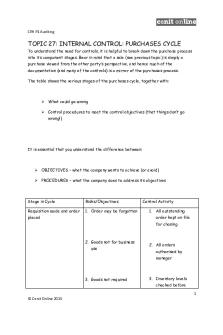Actuarial Control Cycle PDF

| Title | Actuarial Control Cycle |
|---|---|
| Course | Actuarial Science |
| Institution | Universiteit Stellenbosch |
| Pages | 3 |
| File Size | 37.7 KB |
| File Type | |
| Total Downloads | 19 |
| Total Views | 165 |
Summary
Short point-style summaries to aid in memorising the work...
Description
Actuarial Control Cycle Management tool that provides a logical framework within which to make business decisions ((Check diagram p161)) 1. The General Economic and Commercial Environment Actuaries must be aware of environment within which they operate Must consider medium- and long-term trends Collect information on, and consider potential changes in 1. Consumer needs 2. Competition 3. Premium rates charged by competition 4. Taxation 5. State of the economy 6. Cultural attitude towards buying insurance 7. Products available in market 8. Distribution channels available 9. Investment available 10. Reinsurance available 11. Availability of capital 12. Commission structure allowed 13. Statutory reserving and minimum solvency requirements 14. Legislation and regulations 15. Underwriting restrictions 16. Expected volume of business sold 17. Anticipated growth in volume 18. Data for estimating mortality 19. Information to judge expected level of expenses 20. Company’s attitude towards risk and returns 21. Relevant professional guidance 2. Professionalism Affects way actuaries carry out work and present advice Actuary has professional responsibility towards - his/her employee/client - policyholder - actuarial profession - regulatory authorities Actuary should - act with integrity - consider any conflicts of interest - provide relevant and ethical solutions - have appropriate experience
- consider the role of the profession in society 3. Specifying the Problem Specify problem Assess risk Provide framework for assessing alternative strategies for handling risks Identify and assess risks faced 1. Adverse mortality 2. Adverse critical illness or sickness rates 3. Adverse investment performance 4. Adverse currency movements 5. Different mix of new businesses by size and nature 6. Different mix of new businesses by sales source 7. Offering onorous guarantees 8. Offering onorous options 9. Taxation changes 10. Regulatory changes 11. Lack of data 12. High expense inflation 13. Poor withdrawal experience 14. Charging too low premiums in order to gain market share 15. Management of company 16. Counterparty failure 17. Political risks 4. Developing the Solution Involves review of actuarial models of cash flows currently in use How they may be adjusted for particular problem to be solved Initial assumptions selected for use of the model by considering - expected volumes of business - main expenses - mortality rates and sums assured Investigate alternative strategies for risk management Predict future results Communicate results clearly so that informed decisions can be made 5. Monitoring the Experience Monitor experience and give feedback into other stages of cycle Monitor expectation v actual experience for - mortality - expenses - withdrawal - business mix and volume
Identify and understand discrepancies Reasons for discrepancies - problem may not have been fulle understood - models or assumptions may have been inappropriate - the general commercial environment may have changed in way not anticipated...
Similar Free PDFs

Actuarial Control Cycle
- 3 Pages

Actuarial studies exemption guide
- 28 Pages

Fundamentals of Actuarial Practice
- 25 Pages

Lecture Notes on Actuarial Mathematics
- 320 Pages

Accounting Cycle-5 - Cycle notes
- 13 Pages

Nociones DE Calculo Actuarial MATE 4
- 12 Pages

2017 B Actuarial Co-op 3587
- 9 Pages
Popular Institutions
- Tinajero National High School - Annex
- Politeknik Caltex Riau
- Yokohama City University
- SGT University
- University of Al-Qadisiyah
- Divine Word College of Vigan
- Techniek College Rotterdam
- Universidade de Santiago
- Universiti Teknologi MARA Cawangan Johor Kampus Pasir Gudang
- Poltekkes Kemenkes Yogyakarta
- Baguio City National High School
- Colegio san marcos
- preparatoria uno
- Centro de Bachillerato Tecnológico Industrial y de Servicios No. 107
- Dalian Maritime University
- Quang Trung Secondary School
- Colegio Tecnológico en Informática
- Corporación Regional de Educación Superior
- Grupo CEDVA
- Dar Al Uloom University
- Centro de Estudios Preuniversitarios de la Universidad Nacional de Ingeniería
- 上智大学
- Aakash International School, Nuna Majara
- San Felipe Neri Catholic School
- Kang Chiao International School - New Taipei City
- Misamis Occidental National High School
- Institución Educativa Escuela Normal Juan Ladrilleros
- Kolehiyo ng Pantukan
- Batanes State College
- Instituto Continental
- Sekolah Menengah Kejuruan Kesehatan Kaltara (Tarakan)
- Colegio de La Inmaculada Concepcion - Cebu








